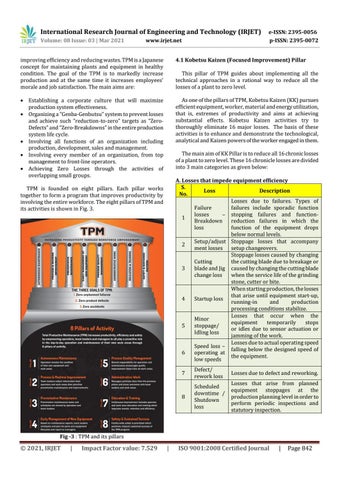International Research Journal of Engineering and Technology (IRJET)
e-ISSN: 2395-0056
Volume: 08 Issue: 03 | Mar 2021
p-ISSN: 2395-0072
www.irjet.net
improving efficiency and reducing wastes. TPM is a Japanese concept for maintaining plants and equipment in healthy condition. The goal of the TPM is to markedly increase production and at the same time it increases employees’ morale and job satisfaction. The main aims are:
4.1 Kobetsu Kaizen (Focused Improvement) Pillar
Establishing a corporate culture that will maximize production system effectiveness. Organizing a “Genba-Genbutsu” system to prevent losses and achieve such “reduction-to-zero” targets as “ZeroDefects” and “Zero-Breakdowns” in the entire production system life cycle. Involving all functions of an organization including production, development, sales and management. Involving every member of an organization, from top management to front-line operators. Achieving Zero Losses through the activities of overlapping small groups.
As one of the pillars of TPM, Kobetsu Kaizen (KK) pursues efficient equipment, worker, material and energy utilization, that is, extremes of productivity and aims at achieving substantial effects. Kobetsu Kaizen activities try to thoroughly eliminate 16 major losses. The basis of these activities is to enhance and demonstrate the technological, analytical and Kaizen powers of the worker engaged in them.
This pillar of TPM guides about implementing all the technical approaches in a rational way to reduce all the losses of a plant to zero level.
The main aim of KK Pillar is to reduce all 16 chronic losses of a plant to zero level. These 16 chronicle losses are divided into 3 main categories as given below: A. Losses that impede equipment efficiency S. Loss Description No. Losses due to failures. Types of Failure failures include sporadic function losses – stopping failures and function1 Breakdown reduction failures in which the loss function of the equipment drops below normal levels. Setup/adjust Stoppage losses that accompany 2 ment losses setup changeovers. Stoppage losses caused by changing Cutting the cutting blade due to breakage or 3 blade and Jig caused by changing the cutting blade change loss when the service life of the grinding stone, cutter or bite. When starting production, the losses that arise until equipment start-up, 4 Startup loss running-in and production processing conditions stabilize. Losses that occur when the Minor equipment temporarily stops 5 stoppage/ or idles due to sensor actuation or Idling loss jamming of the work. Losses due to actual operating speed Speed loss – falling below the designed speed of 6 operating at the equipment. low speeds
TPM is founded on eight pillars. Each pillar works together to form a program that improves productivity by involving the entire workforce. The eight pillars of TPM and its activities is shown in Fig. 3.
7
Defect/ rework loss
Losses due to defect and reworking.
8
Scheduled downtime / Shutdown loss
Losses that arise from planned equipment stoppages at the production planning level in order to perform periodic inspections and statutory inspection.
Fig -3 : TPM and its pillars
© 2021, IRJET
|
Impact Factor value: 7.529
|
ISO 9001:2008 Certified Journal
|
Page 842



